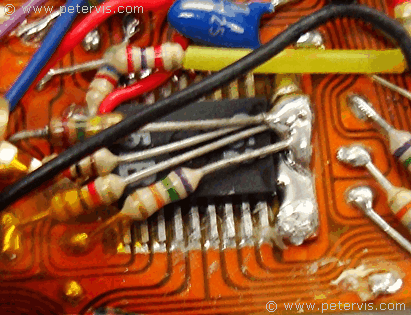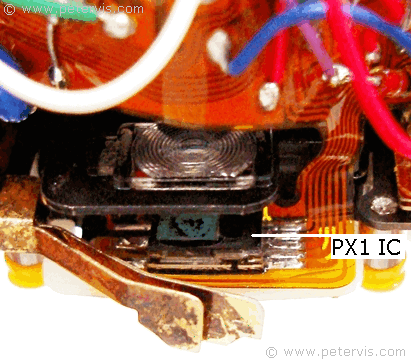Canon AE-1 Jammed Shutter Repair
This Canon AE-1 had a jammed shutter, and whilst it was possible to clear the jam temporarily by mechanical means, there was clearly an electronic fault, and therefore I decided to do what doctors call an "exploratory" by removing the top cover.


I was looking for any kind of fault such as a break in the flex circuit, or perhaps dry solder joints. I am sure this camera came out of the factory operational; however, there must have been some deterioration of components resulting in the fault. The small dents and scrapes on the camera body were consistent with abuse marks caused by the previous owner thumping the camera, when it did not work. This indicated an intermittent fault caused by poor electrical contacts.

This is PX2 on the film advance side.

For better access to the pins, I de-soldered the blue tantalum capacitor. The one significant fault I found was dry and missing solder on the integrated circuit (IC) pins. Many pins had extremely thin soldering; however, some pins were missing solder altogether. The electrical contact may have been sufficient when new, however oxidation, over time, could cause poor electrical contacts. The solution was therefore to solder all the pins with fresh solder. This is where a stereomicroscope and extremely fine tipped soldering iron are essential...

This is PX3 on the film rewind side.

After re-soldering all the pins, the viewfinder came back to life, and the shutter stopped jamming, however I noticed that the camera needle was not very sensitive to the varying light levels. This meant some more exploratory surgery was in order.

I decided to have a look at the third elusive IC PX1, which has a built-in photo-sensor. This IC has a square window, with a light sensor behind it. PX1 is above the viewfinder lens, and from behind, it senses the light coming from the apex point of the prism. In this photo, the prism is under the flex circuit, and light from the prism passes through a Fresnel type lens assembly and onto the light sensor window of the PX1 IC.

A close look at the IC under a microscope revealed a greenish colour behind its clear window indicating oxidation of copper. Somehow, air and moisture must have been able to get into it causing the oxidation to form, and therefore it was not operating to its peak efficiency. At this point, I decided to pack it up because a replacement IC would be difficult to source.
This Article Continues...
Canon AE-1Canon AE-1 Review
Canon AE-1 Price
Canon AE-1 Battery
Canon AE-1 Open Back
Canon AE-1 Rewind Film
Canon AE-1 How to Load 35mm Film
Canon AE-1 Jammed Shutter
Canon AE-1 Repair
Canon AE-1 Jammed Shutter Repair
